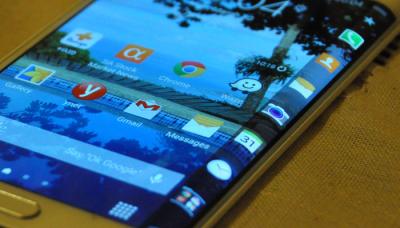Super AMOLED: introduction and market status
OLED displays use organic materials that emit light when electricity is applied. OLEDs enable emissive, bright, thin, flexible and efficient displays. OLEDs are replacing LCDs in most display applications - from smartphones and wearables to monitors and TVs.

Samsung's Super AMOLED displays, announced in 2010, are AMOLED displays for mobile devices (such as smartphones, wearables and tablets) with an integrated touch function. The thickness of the touch sensor is just 0.001 mm and this allows the screen to provide better images and to have great visibility even in direct sunlight compared with regular AMOLED displays with an external touch layer.
Samsung is producing hundreds of millions of Super AMOLED displays today, used mostly in smartphones, but also in other devices. These are considered to be some of the best displays on the market.
Super AMOLED and the Pentile matrix
Samsung's Super AMOLED displays use a Pentile matrix sub-pixel design. That means that the green sub-pixel is shared by two pixels and the display has only 2 sub-pixels per real 'pixel' compared to the classic RGB matrix design (or Real-Stripe). You can see a PenTile matrix vs a Real-Stripe one on the images below (the PenTile is on the right). Newer Super AMOLED displays use a different PenTile matrix (Diamond Pixel pattern).
Super AMOLED vs Dynamic AMOLED
In 2019 Samsung introduced its next-generation mobile display technology, which it calls Dynamic AMOLED. Basically a Dynamic AMOLED is similar to a Super AMOLED display, but it adds HDR support. Samsung's highest end smartphones adopt the company's Dynamic AMOLED 2X LTPO AMOLED displays.
Further reading
- Introduction to OLEDs
- Samsung's OLED displays
- Pentile Technology explained
- Flexible OLEDs
- OLED mobile phones
- The OLED Toolbox: a one-stop-shop for OLED information, insights, analysis and guides
T-Mobile is now selling the Samsung Vibrant (Galaxy S) for $99
A few days ago we we reported that AT&T is selling the Samsung Captivate phone now for $200, and now we hear (thanks Eric!) that T-Mobile is selling the same phone, only calling it Samsung Vibrant for $99 with a service plan. The Vibrant (Galaxy S) is an Android phone with a 4" WVGA 800 X 480 Super-AMOLED display. Samsung has already sold more than a million such phones globally, in just 3 weeks.
You can buy the Samsung Vibrant for $99 (with a new service plan), or you can buy the Galaxy S unlocked for $599.
Samsung's Super-AMOLED "key engineer" now works for LG, companies in legal battle
One of Samsung's "key engineers", who was involved with the development of Super-AMOLED displays is now working to LG. Samsung is suing him - one of the terms of his employment was that he can't work for a rival company for 2 years after he leaves Samsung.
AT&T is now selling the Samsung Captivate (Galaxy S) for $200
AT&T is selling the Samsung Captivate phone now for $200, with a service plan. The Captivate (Galaxy S) is an Android phone with a 4" WVGA 800 X 480 Super-AMOLED display. Samsung has already sold more than a million such phones globally, in just 3 weeks.
 Samsung Captivate
Samsung Captivate
You can buy the Samsung Captivate for AT&T ($200), or you can buy it unlocked for $599.
Samsung sold over 2 million Galaxy S and Wave phones, expects to ship 10 million Galaxy S phones
Samsung says that they have sold over a million Galaxy S phones globally in 3 weeks. They have also sold over a million Wave phones so far. Samsung aims to sell 10 million Galaxy S phones globally. We hope that they'll have enough Super-AMOLED displays...
 Samsung Wave s8500
Samsung Wave s8500The Wave has a 3.3" Super-AMOLED, and runs the Bada OS. It's shipping in the US, unlocked for $399. The Galaxy-S has a larger (4") Super-AMOLED and runs Android. You can buy the Galaxy S unlocked for $599.
Samsung Captivate (Galaxy S) to launch for AT&T on July 18th for $200
The Samsung Captivate (Galaxy S) will launch on the AT&T network on July 18th, for $200 (on-contract). The Captivate is an Android phone with a 4" 800 X 480 Super-AMOLED, 1Ghz processor and can record HD video.
 Samsung Galaxy S
Samsung Galaxy S
Samsung sold 200,000 Galaxy S phones in 10 days in Korea
Samsung has sold over 200,000 Galaxy S phones in South Korea - in just 10 days. That's a very good number for the Korean market. The Galaxy S Android phone has a 4" 800x480 Super-AMOLED display, 1Ghz Processor and can shoot HD videos (720p). You
can buy the Galaxy S unlocked in the US for $599.
 Samsung Galaxy S
Samsung Galaxy S
The Super-AMOLED Samsung Wave unlocked - now for only $399 (down from $499)
A few days ago we reported that the Samsung S8500-Wave phone is finally shipping in the US - and it costs $499 unlocked. The phone is now selling for only $399 - that's a nice $100 discount in a few days.... The wave is Samsung's first Bada phone, and the first one to have a super AMOLED display (3.3" 800x480). Other features include Bluetooth 3.0, Wi-Fi, a 1Ghz processor, 5Mp camera, a-GPS, accelerometer, 2GB/8GB of internal memory, micro-SD slot DivX/XViD support and 720p recording/encoding.
 Samsung Wave s8500
Samsung Wave s8500Buy the S8500 Wave now, unlocked for $399.
The Samsung Wave is shipping in the US, $499 unlocked
Samsung's S8500-Wave phone is finally shipping in the US - you can buy it unlocked for $499. The wave is Samsung's first Bada phone, and the first one to have a super AMOLED display (3.3" 800x480). Other features include Bluetooth 3.0, Wi-Fi, a 1Ghz processor, 5Mp camera, a-GPS, accelerometer, 2GB/8GB of internal memory, micro-SD slot DivX/XViD support and 720p recording/encoding.
 Samsung Wave s8500
Samsung Wave s8500Buy the S8500 Wave now, unlocked for $499.
Rumors: Nokia's working on a QWERTY slider with a Super-AMOLED
 There are some rumors about an upcoming Nokia phone, the N9. It is said to be a Symbian ^3 phone with a slide-out QWERTY keyboard. It will have a 12mp camera and a Super-AMOLED display.
There are some rumors about an upcoming Nokia phone, the N9. It is said to be a Symbian ^3 phone with a slide-out QWERTY keyboard. It will have a 12mp camera and a Super-AMOLED display.
There are some questions here: first of all, Nokia said last week that the N8 will be the latest N-series that runs Symbian. Second, We heard that Samsung Electronics will be the only company that gets Super-AMOLED displays, for at least 18 months. We'll keep waiting for news on that one.
Engadget's take on the Retina vs Super-AMOLED test
Engadget is the latest blog to test the iPhone's new "Retina" IPS-LCD display against Samsung's Super-AMOLED (Galaxy S phone). The iPhone display is much brighter, and actually has a slightly better viewing angle. When viewed outside, they actually prefer the Super-AMOLED, although the displays are quite similar in that area. Obviously the iPhone's 4 resolution is way better. The Super-AMOLED is said to have stronger color saturation and sharper definition, even though it looks pixelated compared to the iPhone's display. Basically what they say is that both displays are good, and it all comes down to personal preference.

Check out the full post, it includes a lot of photos and a couple of videos.
Pagination
- Previous page
- Page 24
- Next page



